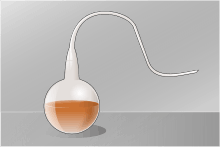Swan neck flask

Louis Pasteur’s spontaneous generation experiment illustrates the fact that the spoilage of liquid was caused by particles in the air rather than the air itself. These experiments were important pieces of evidence supporting the idea of germ theory of disease.

Bottle en col de cygne (Gooseneck bottle) used by Louis Pasteur
A swanneck (or gooseneck) flask is a particular shape of normally plastic or glass tube leading into a test tube or other vessel. The "swan neck" significantly slows down the motion of air through the tube, and particles in the air, such as bacteria, become trapped on moisture on its inner surfaces. As a result, sterile liquid in the vessel itself remains sterile as long as the liquid does not contact the contaminated liquid in the tube. Louis Pasteur developed and used this apparatus in the early 1860s to prove that particles in the air (germ theory), rather than the air itself (spontaneous generation), led to fermentation.[1][2]
References
This article is issued from
Wikipedia.
The text is licensed under Creative Commons - Attribution - Sharealike.
Additional terms may apply for the media files.